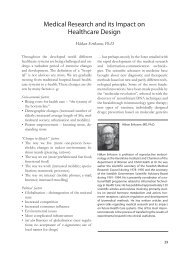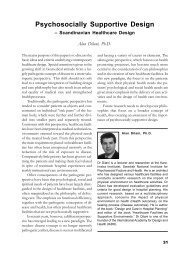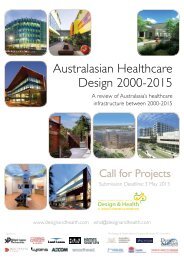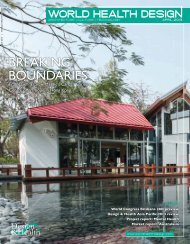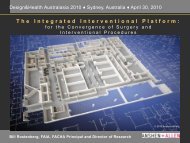SUPER GREEN - the International Academy of Design and Health
SUPER GREEN - the International Academy of Design and Health
SUPER GREEN - the International Academy of Design and Health
- No tags were found...
Create successful ePaper yourself
Turn your PDF publications into a flip-book with our unique Google optimized e-Paper software.
Market Report: Eastern EuropeIt has been 17 years since <strong>the</strong> collapse <strong>of</strong> <strong>the</strong> Soviet Union, but it is only now that <strong>the</strong> rebuilding <strong>of</strong> <strong>the</strong> healthcare sector in <strong>the</strong>countries <strong>of</strong> <strong>the</strong> former USSR <strong>and</strong> Eastern Europe is really beginning to get under way. Years <strong>of</strong> neglect have left buildings in a poorcondition, impacting on patient care. And as <strong>the</strong>y look for ways to modernise, architects <strong>and</strong> construction specialists from around <strong>the</strong>world are looking at how <strong>the</strong>y can get involved.During <strong>the</strong> Soviet era, health was not a priority <strong>and</strong> investment was low. At <strong>the</strong> same time, <strong>the</strong>re were large numbers <strong>of</strong> smallhospitals. The primary care sector was relatively undeveloped, hospitals were <strong>of</strong>ten disease-focused <strong>and</strong> <strong>the</strong>re were parallel healthsystems for specifi c sectors, such as <strong>the</strong> army, <strong>the</strong> police or transport, each with <strong>the</strong>ir own set <strong>of</strong> hospitals <strong>and</strong> medical care.In <strong>the</strong> USSR, funding was focused on bed numbers ra<strong>the</strong>r than <strong>the</strong> care provided. This, says Bernd Rechel from <strong>the</strong> LondonSchool <strong>of</strong> <strong>Health</strong> <strong>and</strong> Tropical Medicine, led to unnecessary hospitalisation <strong>and</strong> an ineffi cient use <strong>of</strong> resources. In its 2004 report onhealthcare in <strong>the</strong> Ukraine 1 , <strong>the</strong> EuropeanObservatory on <strong>Health</strong> Systems <strong>and</strong>EasternPolicies said: “Despite <strong>the</strong> limited resourcesavailable for <strong>the</strong> healthcare system, planningcontinued to be oriented towards <strong>the</strong> goal<strong>of</strong> ever-increasing capacity, measured by<strong>the</strong> number <strong>of</strong> hospital beds <strong>and</strong> <strong>of</strong> healthpromiseThe modernisation <strong>of</strong> healthcare facilities <strong>and</strong> reform <strong>of</strong><strong>the</strong> healthcare sector is gaining pace in Russia <strong>and</strong> EasternEurope. Kathleen Armstrong looks at recent developments<strong>and</strong> <strong>the</strong> challenges <strong>and</strong> opportunities <strong>the</strong>y providepersonnel. As a result, Ukraine, as manyo<strong>the</strong>r former Soviet republics, had one <strong>of</strong><strong>the</strong> world’s highest numbers <strong>of</strong> hospitalbeds <strong>and</strong> physicians per capita. Inevitably,increased quantity was at <strong>the</strong> expense<strong>of</strong> quality, <strong>and</strong> in many cases encouragedharmful practices such as lengthyhospitalisations for minor disorders.”Under-investment in facilities meant thatsome hospitals in rural areas didn’t evenhave basic amenities, such as running wateror sewerage 2 .After <strong>the</strong> fall <strong>of</strong> <strong>the</strong> Soviet Union, most<strong>of</strong> <strong>the</strong> countries in <strong>the</strong> former USSR <strong>and</strong>in Eastern Europe fell into a period <strong>of</strong>economic decline <strong>and</strong>, as a result, healthcaresuffered fur<strong>the</strong>r. In Russia, <strong>the</strong> “worseningeconomic situation in <strong>the</strong> 1980s <strong>and</strong> 1990sled to a slow deterioration in services, asequipment became antiquated or needed to be replaced, drug stocksdwindled <strong>and</strong> <strong>the</strong> fabric <strong>of</strong> buildings decayed” 2 .A mixed storyCountries in <strong>the</strong> region are now stepping up investment in <strong>the</strong> sector.Funding is most secure in Russia <strong>and</strong> Kazakhstan who are reaping <strong>the</strong>benefi ts <strong>of</strong> <strong>the</strong> oil boom <strong>and</strong>, <strong>the</strong>refore, have more funding availableMedicover Hospital, WarsawCost: approx £13million (at 2006 prices)Client: MedicoverLead Consultant: ArupArchitect: Nightingale Associates <strong>and</strong> Atelier 7<strong>Health</strong> Planners: TribalStructural Engineer: ArupServices <strong>and</strong> Environmental Engineer: ArupQuantity Surveyor <strong>and</strong> Planning Supervisor: ArupL<strong>and</strong>scape Architect: Atelier 728 October 2008 | WORLD HEALTH DESIGN



